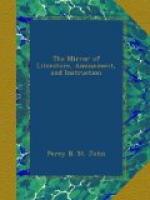From the refectory and the dormitory we were conducted to the chapel, with renewed injunctions to ask no questions while there, and to preserve the strictest silence. Here we found about thirty, I think, of the brethren, in their coarse black habits and cord belts, with rosary, shaved crowns, and fixed eyes; some kneeling, and others prostrate upon the stony floor,—picturesquely grouged, a la Rembrandt, about the steps of the altar and other parts of the chapel. All were silent and motionless, and regarded our intrusion no more than if they were so many marble statues. Some of the monks were old and haggard, and others young and better conditioned than might be conceived of men fed, or rather starved, as they were represented to be. Their features appeared generally to be coarse and vulgar. The chapel itself was perfectly plain, and unadorned but by a few of the customary figures and paintings, representing disgusting situations of saints and martyrs under voluntary torture and privation. Lamps that “shed a pale and ineffectual light,” crucifixes, and images of the Virgin and Son, were duly scattered about the niches of the chapel.
From the chapel we were conducted to the superior’s room, a small scantily-furnished apartment, with however an appearance of greater comfort than elsewhere about the building, from the presence of a plain chair and table, some religious books, a cot, and a little fire. The superior himself possessed somewhat more of the aspect of a gentleman than the rest of the brethren, as well as the dim light of a lamp allowed us to observe his figure; of which certainly, whatever might have been his mode of living, rotundity formed no such feature as I have seen among the jolly monks in Spain and Portugal. He related to us the habits of his order, from which we learnt further particulars than had been related by the cicerone. Silence seemed to be the rule of the establishment during the whole twenty-four hours, the exceptions being very few: one of the brethren, we were told, had never been known to speak for about thirty years, in accordance with a vow, and was supposed to have become dumb.
When one monk met another, the salutation was limited to this simple expression—“Brother, we must die.” And lest this fact should not have been sufficiently kept in recollection, a grave was constantly open in the burying-ground at hand, the digging of which was a source of bodily exercise and recreation to the brethren; a new one being always made when a tenant was found for that which already gaped to receive him.
I need scarcely observe, that from the rigid silence vowed and practised, the order of La Trappe includes no females in its over-zealous ordinances. The only books allowed those who could read were Missals and the Bible, which were constantly in their hands.
Medical aid was not denied, when occasion required it, from one qualified to practise among the Weld colony in the village, who of course was no heretic; but the ordinary management of the materia medica, furnished by the garden, rested with such of the fraternity as were gifted in the art of healing.




